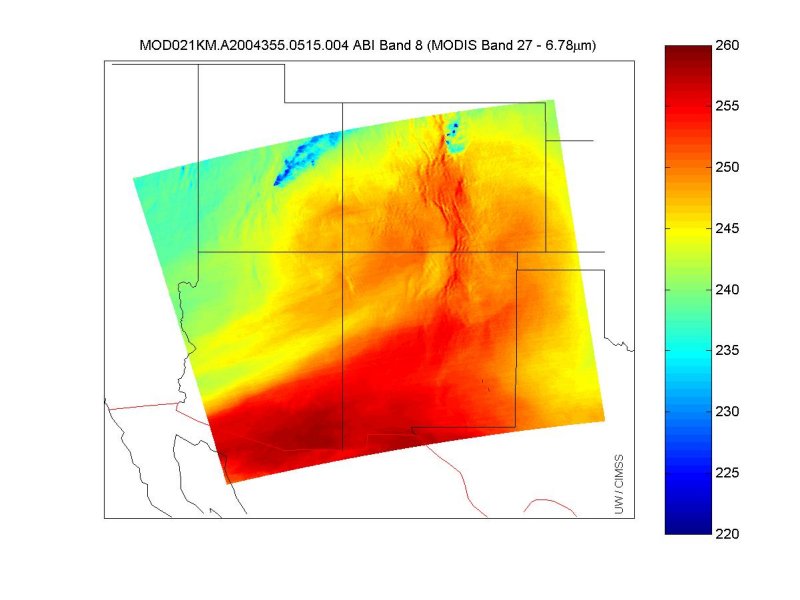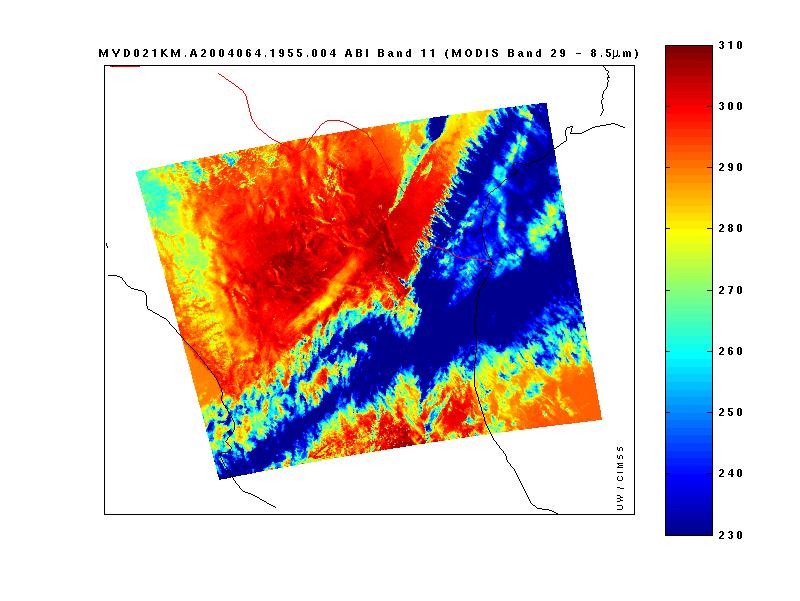-
DATA
Proxy ABI Data Sets For Compression
Contents:
The data files are provided as Matlab .mat files on an
ftp site. There is a separate .mat file for each ABI band, the navigation data, and the lookup tables to convert
the scaled radiances (integers) to real radiances (modis radiances units). There is also a data file that contains
all of the bands and navigation data (you still need the lookup tables).
The 1.6 µm band on Aqua MODIS has a number of bad detectors which cause striping. This corresponds
to band 05 on ABI. As such, for Aqua daytime cases, there is no ABI band 05 data provided since the
striping would alter compression results in a way not anticipated to occur with ABI. That band is still
provided for cases derived from Terra MODIS. Aqua MODIS data files begin with "MYD"; Terra MODIS data files
begin with "MOD".
There is a sample Matlab .m script that shows how to load the data and will display an image of a band of
interest for that case. You must have the mapping toolbox for Matlab for the figure to display or find
another way to display the data. This m-file calls another m-file which converts MODIS radiances to
brightness temperatures for the purposes of displaying. Strictly speaking, these m-files aren't needed for
compression studies though they may give you some insight as to what data is stored in what files.
MYD021KM.A2003300.2055.003_count2rad_ABIbitdepth_lookuptables.mat
OR...
OR...
MOD021KM.A2004355.0515.004_count2rad_ABIbitdepth_lookuptables.mat
OR...
OR...
MOD021KM.A2004329.1640.004_count2rad_ABIbitdepth_lookuptables.mat
OR...
OR...
MOD021KM.A2002219.1550.004_count2rad_ABIbitdepth_lookuptables.mat
OR...
OR...
MYD021KM.A2004064.1955.004_count2rad_ABIbitdepth_lookuptables.mat
OR...
OR...
MOD021KM.A2008099.2055.005_count2rad_ABIbitdepth_lookuptables.mat
OR... The unaltered MODIS data for the above cases can be obtained from the NASA Goddard Earth Sciences Data and
Information Services Center (GES DISC) Distrubuted Active Archive Center (DAAC)
or specifically from their MODIS Data Support page.
These files have been compressed using bzip2 to save space and are in hdf5 format.
See this EUMETSAT page for more information on Seviri (MET-8).
EUMETSAT provides a Java interface to download MSG data and it can be found here at: UMARF.
See this GOES Imager Info Page for
more information on the GOES Imager bands.
See this GVAR Conversion page to learn how to
convert GVAR counts.
See this About MTSAT and its
system page for more information on the MTSAT.
NOTICE: The images, text, and other information on these web pages
are proprietary information belonging to The Cooperative Institute for
Meteorological Satellite Studies at the University of Wisconsin-Madison.
If the informationis of use to you, please give proper credit to CIMSS.
Thanks!
Last Updated: April 15, 2008
Bit-depth simulated ABI compression study data sets:
These are on anonymous ftp at ftp.ssec.wisc.edu in separate directories for each case
Alternatively, there is a netcdf file containing all of the data, navigation, and lookup tables for each band. The variables
contained in this netcdf file look similar to this for a day time case:
cd ABI/compression/bitdepth_testdata/modis
bin
prompt
mget *.m
bye
NOTE: Appropriate mget commands listed below for each case
For a nighttime case, there won't be any visible data (variables related to ABI Bands 1-6 won't appear in those files, including
navigational parameters for 1km and hkm data).
Fire and Smoke Case (Day Time - IR and Vis)
MYD021KM.A2003300.2055.003_navdata.mat
MYD021KM.A2003300.2055.003_to_10bit_ABIband01.mat
MYD021KM.A2003300.2055.003_to_12bit_ABIband02.mat
MYD021KM.A2003300.2055.003_to_10bit_ABIband03.mat
MYD021KM.A2003300.2055.003_to_10bit_ABIband04_2km.mat
MYD021KM.A2003300.2055.003_to_10bit_ABIband06_2km.mat
MYD021KM.A2003300.2055.003_to_14bit_ABIband07_2km.mat
MYD021KM.A2003300.2055.003_to_11bit_ABIband09_2km.mat
MYD021KM.A2003300.2055.003_to_12bit_ABIband10_2km.mat
MYD021KM.A2003300.2055.003_to_12bit_ABIband11_2km.mat
MYD021KM.A2003300.2055.003_to_11bit_ABIband12_2km.mat
MYD021KM.A2003300.2055.003_to_12bit_ABIband14_2km.mat
MYD021KM.A2003300.2055.003_to_12bit_ABIband15_2km.mat
MYD021KM.A2003300.2055.003_to_11bit_ABIband16_2km.mat
MYD021KM.A2003300.2055.003_to_ABIbitdepth_all.mat
cd ABI/compression/bitdepth_testdata/modis/2003300
bin
prompt
mget MYD021KM.A2003300.2055*.mat
MYD021KM.A2003300.2055.003_to_ABIbitdepth_all.nc.Z
Mountain Wave Case (Night Time - IR Only)
MOD021KM.A2004355.0515.004_navdata.mat
MOD021KM.A2004355.0515.004_to_14bit_ABIband07_2km.mat
MOD021KM.A2004355.0515.004_to_11bit_ABIband09_2km.mat
MOD021KM.A2004355.0515.004_to_12bit_ABIband10_2km.mat
MOD021KM.A2004355.0515.004_to_12bit_ABIband11_2km.mat
MOD021KM.A2004355.0515.004_to_11bit_ABIband12_2km.mat
MOD021KM.A2004355.0515.004_to_12bit_ABIband14_2km.mat
MOD021KM.A2004355.0515.004_to_12bit_ABIband15_2km.mat
MOD021KM.A2004355.0515.004_to_11bit_ABIband16_2km.mat
MOD021KM.A2004355.0515.004_to_ABIbitdepth_all.mat
cd ABI/compression/bitdepth_testdata/modis/2004355
bin
prompt
mget MOD021KM.A2004355.0515*.mat
MOD021KM.A2004355.0515.004_to_ABIbitdepth_all.nc.Z
Convective Cloud Case (Day Time - IR and Vis)
MOD021KM.A2004329.1640.004_navdata.mat
MOD021KM.A2004329.1640.004_to_10bit_ABIband01.mat
MOD021KM.A2004329.1640.004_to_12bit_ABIband02.mat
MOD021KM.A2004329.1640.004_to_10bit_ABIband03.mat
MOD021KM.A2004329.1640.004_to_10bit_ABIband04_2km.mat
MOD021KM.A2004329.1640.004_to_10bit_ABIband05.mat
MOD021KM.A2004329.1640.004_to_10bit_ABIband06_2km.mat
MOD021KM.A2004329.1640.004_to_14bit_ABIband07_2km.mat
MOD021KM.A2004329.1640.004_to_11bit_ABIband09_2km.mat
MOD021KM.A2004329.1640.004_to_12bit_ABIband10_2km.mat
MOD021KM.A2004329.1640.004_to_12bit_ABIband11_2km.mat
MOD021KM.A2004329.1640.004_to_11bit_ABIband12_2km.mat
MOD021KM.A2004329.1640.004_to_12bit_ABIband14_2km.mat
MOD021KM.A2004329.1640.004_to_12bit_ABIband15_2km.mat
MOD021KM.A2004329.1640.004_to_11bit_ABIband16_2km.mat
MOD021KM.A2004329.1640.004_to_ABIbitdepth_all.mat
cd ABI/compression/bitdepth_testdata/modis/2004329
bin
prompt
mget MOD021KM.A2004329.1640*.mat
MOD021KM.A2004329.1640.004_to_ABIbitdepth_all.nc.Z
Daytime Cloud Case (Day Time - IR and Vis)
MOD021KM.A2002219.1550.004_navdata.mat
MOD021KM.A2002219.1550.004_to_10bit_ABIband01.mat
MOD021KM.A2002219.1550.004_to_12bit_ABIband02.mat
MOD021KM.A2002219.1550.004_to_10bit_ABIband03.mat
MOD021KM.A2002219.1550.004_to_10bit_ABIband04_2km.mat
MOD021KM.A2002219.1550.004_to_10bit_ABIband05.mat
MOD021KM.A2002219.1550.004_to_10bit_ABIband06_2km.mat
MOD021KM.A2002219.1550.004_to_14bit_ABIband07_2km.mat
MOD021KM.A2002219.1550.004_to_11bit_ABIband09_2km.mat
MOD021KM.A2002219.1550.004_to_12bit_ABIband10_2km.mat
MOD021KM.A2002219.1550.004_to_12bit_ABIband11_2km.mat
MOD021KM.A2002219.1550.004_to_11bit_ABIband12_2km.mat
MOD021KM.A2002219.1550.004_to_12bit_ABIband14_2km.mat
MOD021KM.A2002219.1550.004_to_12bit_ABIband15_2km.mat
MOD021KM.A2002219.1550.004_to_11bit_ABIband16_2km.mat
MOD021KM.A2002219.1550.004_to_ABIbitdepth_all.mat
cd ABI/compression/bitdepth_testdata/modis/2002219
bin
prompt
mget MOD021KM.A2002219.1550*.mat
MOD021KM.A2002219.1550.004_to_ABIbitdepth_all.nc.Z
Mexican Dust Case (Day Time - IR and Vis)
MYD021KM.A2004064.1955.004_navdata.mat
MYD021KM.A2004064.1955.004_to_10bit_ABIband01.mat
MYD021KM.A2004064.1955.004_to_12bit_ABIband02.mat
MYD021KM.A2004064.1955.004_to_10bit_ABIband03.mat
MYD021KM.A2004064.1955.004_to_10bit_ABIband04_2km.mat
MYD021KM.A2004064.1955.004_to_10bit_ABIband06_2km.mat
MYD021KM.A2004064.1955.004_to_14bit_ABIband07_2km.mat
MYD021KM.A2004064.1955.004_to_11bit_ABIband09_2km.mat
MYD021KM.A2004064.1955.004_to_12bit_ABIband10_2km.mat
MYD021KM.A2004064.1955.004_to_12bit_ABIband11_2km.mat
MYD021KM.A2004064.1955.004_to_11bit_ABIband12_2km.mat
MYD021KM.A2004064.1955.004_to_12bit_ABIband14_2km.mat
MYD021KM.A2004064.1955.004_to_12bit_ABIband15_2km.mat
MYD021KM.A2004064.1955.004_to_11bit_ABIband16_2km.mat
MYD021KM.A2004064.1955.004_to_ABIbitdepth_all.mat
cd ABI/compression/bitdepth_testdata/modis/2004064
bin
prompt
mget MYD021KM.A2004064.1955*.mat
MYD021KM.A2004064.1955.004_to_ABIbitdepth_all.nc.Z
Hawaii SO2 Case (Day Time - IR and Vis)
MOD021KM.A2008099.2055.005_navdata.mat
MOD021KM.A2008099.2055.005_to_10bit_ABIband01.mat
MOD021KM.A2008099.2055.005_to_12bit_ABIband02.mat
MOD021KM.A2008099.2055.005_to_10bit_ABIband03.mat
MOD021KM.A2008099.2055.005_to_10bit_ABIband04_2km.mat
MOD021KM.A2008099.2055.005_to_10bit_ABIband06_2km.mat
MOD021KM.A2008099.2055.005_to_14bit_ABIband07_2km.mat
MOD021KM.A2008099.2055.005_to_11bit_ABIband09_2km.mat
MOD021KM.A2008099.2055.005_to_12bit_ABIband10_2km.mat
MOD021KM.A2008099.2055.005_to_12bit_ABIband11_2km.mat
MOD021KM.A2008099.2055.005_to_11bit_ABIband12_2km.mat
MOD021KM.A2008099.2055.005_to_12bit_ABIband14_2km.mat
MOD021KM.A2008099.2055.005_to_12bit_ABIband15_2km.mat
MOD021KM.A2008099.2055.005_to_11bit_ABIband16_2km.mat
MOD021KM.A2008099.2055.005_to_ABIbitdepth_all.mat
cd ABI/compression/bitdepth_testdata/modis/2008099
bin
prompt
mget MOD021KM.A2008099.2055*.mat
Unaltered MODIS data
Unaltered MET-8 Full Disk Images
These are on anonymous ftp at ftp.ssec.wisc.edu
ftp://ftp.ssec.wisc.edu/ABI/compression/bitdepth_testdata/met8
ftp ftp.ssec.wisc.edu
cd ABI/compression/bitdepth_testdata/met8
bin
prompt
mget MET8*.nc
OR
mget MET8*.mat
bye
There are 11 bands for 3 sequential (at 15 minutes) images for those interested in simulating compression of full disk images.
There has been nothing done to these images other than to take them from McIDAS AREA format and convert them (via McIDAS) to
netCDF. The .mat versions were made by reading in the netCDF files into Matlab and then saving them as individual bands: they are
structured arrays which include for latitude, longitude, and data (which are MET-8 counts). MET-8 data are 10-bit.
There is an additional day's worth of data from 10 April 2006 (24 images, 1 per hour)...
ftp://ftp.ssec.wisc.edu/ABI/compression/bitdepth_testdata/met8_20060410
ftp ftp.ssec.wisc.edu
cd ABI/compression/bitdepth_testdata/met8_20060410
bin
prompt
mget MSG*.bz2
bye
Unaltered GOES-12 Imager Full Disk Images
These are on anonymous ftp at ftp.ssec.wisc.edu
ftp://ftp.ssec.wisc.edu/ABI/compression/bitdepth_testdata/goes12
cd ABI/compression/bitdepth_testdata/goes12
bin
prompt
mget GOES12*.mat
bye
There are 5 bands for 2 separate images (05:45Z and 17:45Z from 19Dec2005) for those interested in
simulating compression of full disk images from the current GOES Imager. The times are representative of a
"night" and "day" case. These files contain latitude, longitude, and GVAR Counts.
They have not been altered in any way other than to convert them from McIdas format to netCDF to Matlab .mat
files. They are structured arrays with the fields latitude, longitude, and raw (counts). Lats and Lons in space are saved as NaN in the .mat
file. The bands are saved individually.
Unaltered MTSAT-1R 10-bit Full Disk Images
These are on anonymous ftp at ftp.ssec.wisc.edu
ftp://ftp.ssec.wisc.edu/ABI/compression/bitdepth_testdata/mtsat
cd ABI/compression/bitdepth_testdata/mtsat
bin
prompt
mget MTSAT*.mat
bye
There are 5 bands for one image time (2:33 UTC on 10 March 2006 for those interested in compressing 10-bit
full disk MTSAT-1R Infrared data. Visible data is 6-bit but has been stretched to 8-bit in this image. The band lineup is as follows: Band 01 is visible; Band 02 is the ~11 micron IR
window band (IR1); Band 3 is the 12 micron dirty window band (IR2); Band 4 is the 6.75 micron water vapor
band (IR3); and Band 05 is the 3.75 micron shortwave window band (IR4). The .mat files contain MTSAT
data as a structured array with data=counts and latitude & longitude values in space are saved as NaN.
The netcdf versions of the files have lat/lons in space of an unreasonably high number (don't use
anything over 180 for longitude for instance). Bands are saved individually.
URL: http://cimss.ssec.wisc.edu/goes/abi/bitdepthcompression/bitdepthbrompression_data.html
Contact the Page Designer: E-Mail Contact Form






